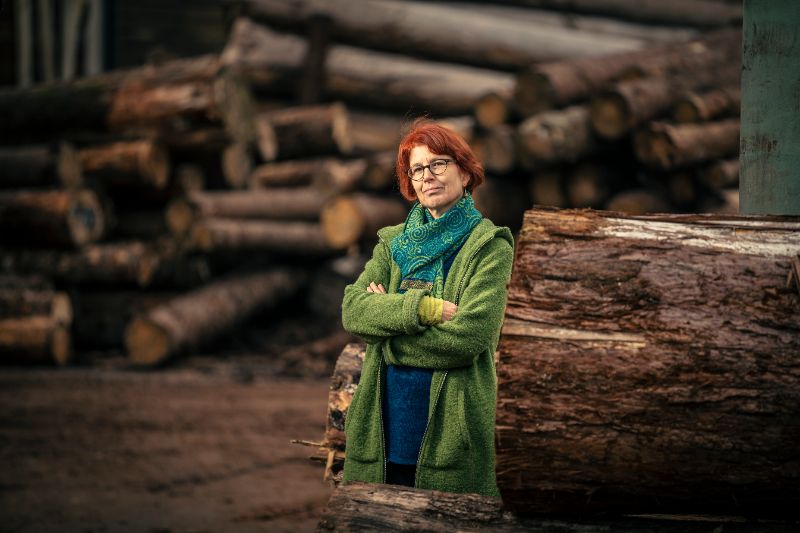“We have to ask some uncomfortable questions”
Ms Björnsen, you led the Energy Change Impact research programme. Are there problems associated with alternative energy sources?
The implementation of the Energy Strategy 2050 requires a radical transformation of the current energy supply. This has some inherent risks and raises new questions that need to be researched. My boss told me: “You will take on the role of the spoilsport who has to critically examine the effects.”
What do you mean by that?
Humanity has invented great technologies that make life easier for us. However, every technology also has negative effects that we could not foresee and now need to correct. Based on our current knowledge, we should be capable of recognising the consequences of our actions and minimising the negative effects of the energy transition. We had to ask uncomfortable questions to reach that point.
For example?
We must ask ourselves which landscapes we are prepared to sacrifice. Densely populated Switzerland does not have unlimited empty spaces in which it can build plants for the production of renewable energy. In addition, unspoilt landscapes and recreational areas are very valuable for both people and nature.
Do you have any answers?
A nationwide survey conducted by WSL and ETH Zurich has shown that the population is mainly in favour of building new plants where infrastructure already exists. This also applies to the Alpine region.
Hydropower remains the most important renewable energy in the country.
It will be expanded further in the future. A great deal of progress has been made in the area of hydropower, for instance to ensure that fish can pass through in spite of dams. Interdisciplinary research teams are working on other issues. For example, sediment transport management is a challenge, also because of climate change: the thawing of permafrost will release much more debris in the future.
So what now?
Researchers from the WSL, Eawag and ETH Zurich are examining diversion tunnels for the debris. In Switzerland, there are currently ten operational sediment bypass tunnels near dams, such as the Solis Reservoir on the River Albula. It is about reducing the siltation of reservoirs and maintaining sediment transport. Artificially generated flood water supplies the underlying river with enough bedload onto which it can “vent its energy”. This prevents the erosion of the banks and creates new habitats.
What other effects is climate change having on hydropower?
An interesting question. Due to its geographical location at the Alpine arch, Switzerland remains a water reservoir. However, the glaciers are disappearing, leaving behind cirques or new lakes. Researchers are investigating the extent to which these could be used as water reservoirs.
What are you thinking about?
Climate models forecast more summer droughts. A team of researchers is currently investigating possible multipurpose uses of water reservoirs. In addition to hydropower, agriculture, drinking water supplies and nature also make demands on the resource.
What role does biomass play?
It is obvious that it should be used. Farmers produce large quantities of farmyard manure, and just under a third of the country is covered in forest. We could get more out of the forest. Low timber prices, an oversupply of low-quality storm-damaged timber and the high costs of the wood harvest make this an unappealing option. A more intensive use of energy can have an impact on the biodiversity of forests. Whether wood can be a sustainable resource in the long term must be carefully clarified. Climate change presents an additional challenge where this is concerned.
In what way?
Although we know how forests will adapt to rising temperatures, our models do not show the effects of extreme periods of drought. The extremely hot summer of 2018, for example, took its toll on beech trees. If pests and storms are then also added to the mix, the availability of resources changes suddenly.
However, farmers reliably produce farmyard manure. Farmers are individualists, their farms are rather small and scattered, making it difficult to use the farmyard manure centrally. The energy transition is not just a technical challenge – it is also always about the people affected.
What are the results of your research programme?
Accurate knowledge of the availability of renewable resources, such as biomass, water, wind and sun. We know how big the potential is and where and when it is available. In coordination with the scenarios for future energy requirements, this data enables well-founded, more cost-effective and more environmentally friendly planning.
How does this now get put into practice?
My favourite topic! Researchers should increasingly keep an eye on the final result of their actions: put knowledge into practice. The early involvement of potential users, perhaps already while formulating research questions, makes it easier for us to transfer knowledge and technology at the end of the process. For this to happen, more resources – and by that I mean not only money, but also staff and time – would have to be made available. Swiss energy researchers have recognised this.
Annual Report 2020
This article was prepared as part of the ETH Board's Annual Report 2020 on the ETH Domain.
